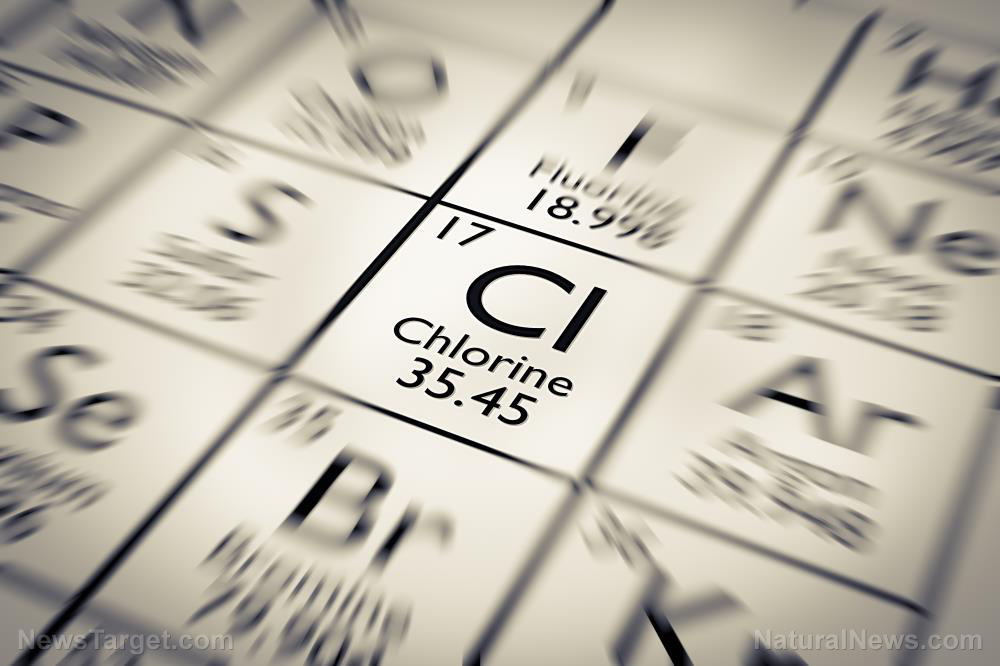CHLORINATED drinking water linked to increased cancer risk, studies reveal
11/19/2025 / By Evangelyn Rodriguez

- Long-term consumption of chlorinated tap water is linked to increased rates of bladder and colorectal cancers due to carcinogenic byproducts like trihalomethanes (THMs).
- Chlorine reacts with organic matter to form THMs, including chloroform, which are tied to cancer, heart disease, reproductive harm and oxidative damage.
- Studies revealing these risks faced publication delays, and regulatory agencies like the EPA have failed to enforce stricter limits and safer alternatives.
- THM exposure is also associated with miscarriages, atherosclerosis, respiratory and skin irritation, and gut microbiome destruction.
- Use carbon or reverse osmosis filters, limit chlorinated pool use, ventilate showers, boost antioxidants (vitamin C and E), and avoid humidifiers with tap water to protect yourself from chlorine’s dangers.
For decades, chlorinated tap water has been considered a hallmark of public health safety—effectively eliminating harmful pathogens and preventing waterborne diseases. Yet mounting scientific evidence suggests that this widespread disinfection method may come at a steep cost: an increased risk of cancer.
Research from institutions such as the Medical College of Wisconsin has uncovered alarming connections between long-term consumption of chlorinated water and elevated rates of colorectal and bladder cancers. With over 98% of U.S. water supplies treated with chlorine, millions of Americans may unknowingly be exposing themselves to carcinogenic byproducts—raising urgent questions about water safety regulations and public health priorities.
Trihalomethanes: The hidden danger in tap water
Chlorine, while effective at killing bacteria, reacts with organic matter in water to form toxic compounds known as trihalomethanes (THMs). These byproducts—including chloroform, a Group B carcinogen—have been linked to serious health risks, including cancer, heart disease and reproductive harm.
A landmark meta-review published in the American Journal of Public Health pooled data from ten studies and found that individuals consuming chlorinated water faced a 21% higher risk of bladder cancer and a 38% increased risk of rectal cancer compared to those drinking non-chlorinated water. The researchers estimated that chlorinated water accounts for 6,500 cases of rectal cancer and 4,200 cases of bladder cancer annually in the U.S.
Further supporting these findings, a Swedish cohort study published in the Journal of the National Cancer Institute tracked nearly 59,000 individuals over 16.8 years. Researchers found that men exposed to higher THM levels (?15 micrograms, mcg/liter, L) faced a significantly elevated risk of colorectal cancer, particularly in the proximal colon.
Other THMs to watch out for, according to BrightU.AI‘s Enoch engine, include bromodichloromethane, dibromochloromethane and bromoform (tribromomethane), all of which are linked to increased risks of bladder, rectal, kidney, stomach, brain and pancreatic cancers, as well as liver damage, reproductive toxicity and neurological effects.
Chlorine’s broader health risks
Despite the mounting evidence, concerns about chlorinated water have often been downplayed or ignored. A co-author of the American Journal of Public Health study revealed that their research was suppressed for a year before publication, with major journals reluctant to publish findings that could alarm the public without presenting an immediate alternative.
When the New York Times finally covered the study, it framed the increased cancer risk as “very slight”—despite the study’s conclusion that chlorinated water was responsible for thousands of cancer cases annually. Meanwhile, the U.S. Environmental Protection Agency (EPA), while acknowledging the potential dangers of THMs, has yet to enforce stricter regulations or mandate safer disinfection alternatives.
The dangers of chlorinated water extend beyond cancer. Studies have linked THM exposure to:
- Increased miscarriage rates in women exposed to high levels of chloroform (even within legal limits).
- Atherosclerosis and heart disease, as evidenced by autopsies of Korean War soldiers who drank heavily chlorinated water.
- Oxidative damage, destroying essential fatty acids, gut bacteria (acidophilus) and antioxidant vitamin E.
- Respiratory and skin irritation, particularly from inhaling chloroform in showers or swimming pools.
Canadian researchers have also found that just one hour in a chlorinated pool significantly increases chloroform levels in the bloodstream. Similarly, hot showers release chloroform vapor, which can be absorbed through the skin and lungs.
Protect yourself from chlorinated water
Given the pervasive presence of chlorine in water supplies, experts recommend several proactive measures to reduce exposure:
- Install high-quality water filters – Carbon block or reverse osmosis filters effectively remove chlorine and THMs from drinking water. Shower filters can also reduce inhalation risks.
- Limit chlorinated pool use – Reduce time spent in chlorinated pools and hot tubs, or opt for saltwater or ozone-treated alternatives.
- Ventilate bathrooms – Leaving windows open during showers helps disperse chloroform vapors.
- Boost antioxidant intake – Vitamin C neutralizes chlorine: One gram can dechlorinate 100 gallons of water. A diet rich in antioxidants (vitamin E, selenium, glutathione) also helps counteract oxidative damage.
- Avoid humidifiers with tap water – Chlorinated water in humidifiers disperses harmful vapors into the air.
While chlorine has played a crucial role in preventing waterborne diseases, its long-term health consequences can no longer be ignored. With thousands of cancer cases linked to chlorinated water each year—and broader risks to cardiovascular and reproductive health—regulators must prioritize safer disinfection methods, such as ozonation or UV treatment, to reduce reliance on chlorine.
In the meantime, public awareness and individual precautions remain essential. As scientific scrutiny grows, the question remains: Will policymakers act to protect public health or will corporate and bureaucratic inertia continue to leave millions at risk?
For now, the responsibility falls on consumers to safeguard their own health—one filtered glass of water at a time.
Learn about the dangers of chlorinated pools by watching this video.
This video is from the Daily Videos channel on Brighteon.com.
Sources include:
Submit a correction >>
Tagged Under:
Bladder cancer, cancer criminals, chlorinated pools, chlorinated water, chlorination, chlorine, Colorectal Cancer, Dangerous, health science, poison, real investigations, research, Suppressed, tap water, toxic chemicals, toxins, Trihalomethanes, water supply
This article may contain statements that reflect the opinion of the author
